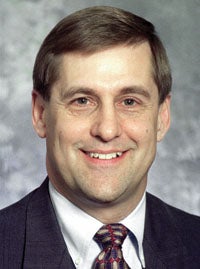The Great Train Robbery revisited
Published 8:52 am Sunday, July 1, 2012
By Phil Krinkie, Guest Column
Few historical heists captivate our imagination like the stories of the legendary outlaws of the American West that robbed trains. From Jesse James to the Wild Bunch and the likes of Butch Cassidy and the Sundance Kid, many thieves claim to have performed “The Great Train Robbery.” But according to the history books the largest train robbery in U.S. history occurred in 1924, when a gang of bandits known as The Newton Gang robbed a mail train in Roundout, Ill. The amount stolen was an estimated $3 million in cash, bonds and jewelry. To this day, not all of the money has been recovered leading to the legend that it may be buried somewhere along the rail line.
 The Newton Gang’s $3 million haul pales in comparison to “The Great Train Robbery of Minnesota” that began in 2009 and continues to drain taxpayers wallets to this day.
The Newton Gang’s $3 million haul pales in comparison to “The Great Train Robbery of Minnesota” that began in 2009 and continues to drain taxpayers wallets to this day.
No, this is not your classic gunslinger desperado story, but a story of deception and miscalculation by our elected officials.
With flashy charts and outlandish performance claims the good taxpayers of Minnesota have been conned into paying for a train that cost four times the original estimates to build, costs twice as much to operate and has only 60% of the estimated riders.
You guessed it — this train robbery is the Northstar Commuter Line.
This ill-conceived, poorly planned, total waste of taxpayer dollars termed the “Northstar Commuter Rail Line” runs from downtown Minneapolis forty miles north to the metropolis of Big Lake Minnesota, population 10,060.
This transit line originally conceptualized and sold as a ‘cure-all’ means to relieve traffic congestion on highway 10 in Anoka County.
The challenge now is what to do with a commuter train few people want to ride and is projected to have an operating cost of $20 million within five years.
Like any bad investment, one solution that is always offered up is to double down and spend more money to turn the project around. This strategy has added another station at the cost of $13 million. The rational behind this plan to add a station in Ramsey (a station that was omitted in the original plan); is with the intent to increase ridership. Of course this is the same argument that was made for adding a station at Foley Boulevard in Coon Rapids during the planning stage of the line.
Another recent proposal to stop the lopsided operating loses is to reduce passenger fares in an attempt to attract more riders. In other words if they make it cheaper, more people will ride the train.
The problem with this theory is that the train already loses $14 million per year. Yes, the commuter rail line that cost over $300 million to build requires a $14 million taxpayer subsidy to operate. That calculates to a subsidy of over $20 per ride, just so somebody doesn’t have to pay to park in downtown Minneapolis.
But wait — there is another idea that will increase ridership on the train that robs taxpayers on every run. Extend the commuter rail line another 40 miles north to St. Cloud. This was the original plan until the Federal Transit Commission nixed the idea back in 2004. Why build a whole train when half will do? Now proponents of the boondoggle complain that this has been the cause of failure all along. So the answer to the lack of riders is to spend hundreds of millions more to expand the line to St. Cloud. If half a dumb idea proves to be failure, let’s build the other half to prove it was really a dumb idea.
The best idea would be to shut down the Northstar rail line and sell the locomotives and passenger cars. The problem is that if the line is shutdown the taxpayers will need to return half of the construction costs to the Federal Government. This leaves the Met Council ( the operating agency) few options in order to stop the waste of taxpayer funds.
Perhaps the Met Council should explore other marketing concepts. Examples would be a dinner train, since the one operated out of Stillwater has shutdown, this could be a great opportunity. Another thought would be to use the train for children’s birthday parties. Kids love trains and since the commuter rail service only operates mornings and late afternoons, the passenger cars could be available during the idle time to host parties. Since Met Council members seem to share the same child-like infatuation with locomotives, maybe they would offer to entertain the children with jokes and balloons.
The sad reality is the Northstar Commuter Line was a hoax from the start and The Great Minnesota Train Robbery will continue to loot taxpayers to pay for the operation costs year after year.
Phil Krinkie, a former eight-term Republican state rep who chaired the House Tax Committee for a while, is president of the Taxpayers League of Minnesota. GOP Gov. Tim Pawlenty appointed Krinkie to the board of the Minnesota State Colleges and Universities system in 2010. You can contact him at: philk@taxpayersleague.org.

